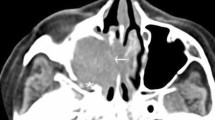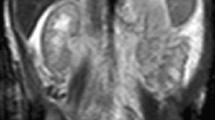Abstract
Introduction
Kaposiform hemangioendothelioma (KHE) is a rare vascular tumor of intermediate malignancy with tendency for local invasion and recurrence. The tumor almost exclusively occurs in children, especially in infants. Intracranial KHE are extremely rare with only two cases reported in the literature.
Report
We report the clinical and pathological features of this rare tumor arising from basitemporal region in a 21-month child. Our case did not present with Kasabach-Merritt phenomenon. Histopathological examination confirmed the diagnosis of KHE.
Conclusion
KHE should be considered in the differential diagnosis of intracranial extra-axial neoplasm in children, and histopathological examination plays an important role in distinguishing KHE from its morphologic mimics. It is essential to diagnose KHE due to its locally aggressive nature.




Similar content being viewed by others
References
Zukerberg LR, Nickoloff BJ, Weiss SW (1993) Kaposiform hemangioendothelioma of infancy and childhood. An aggressive neoplasm associated with Kasabach-Merritt syndrome and lymphangiomatosis. Am J Surg Pathol 17:321–328
Weiss SW (2013) Kaposiform haemangioendothelioma. In: Fletcher CDM, Bridge JA, Hogendoorn PCW, Mertens F (eds) WHO Classification of Tumours of Soft Tissue and Bone, 4th edn. IARC, Lyon, pp 145–146
Chang JM, Kwon BJ, Han MH, Kang HS, Chang KH (2006) Kaposiform hemangioendothelioma arising from the internal auditory canal. Am J Neuroradiol 27:931–933
Chung MT, Chen CH, Chiu CH, Yang CP, Hsueh C, Jaing TH (2003) Successful nonoperative therapy for Kaposiform hemangioendothelioma involving the neck: report of 1 case. Otolaryngol Head Neck Surg 129:605–607
Defatta RJ, Verret DJ, Adelson RT, Gomez A, Myers LL (2005) Kaposiform hemangioendothelioma: case report and literature review. Laryngoscope 115:1789–1792
Hardisson D, Prim MP, De Diego JI, Patrón M, Escribano A, Rabanal I (2002) Kaposiform hemangioendothelioma of the external auditory canal in an adult. Head Neck 24:614–617
Cho WS, Kim SK, Park SH, Cho BK (2009) Intracranial kaposiform hemangioendothelioma: proposal of a new malignant variant. J Neurosurg Pediatrics 3:147–150
Tsang WY, Chan JK (1991) Kaposi-like infantile hemangioendothelioma. A distinctive vascular neoplasm of the retroperitoneum. Am J Surg Pathol 15:982–989
Liu Q, Jiang L, Wu D, Kan Y, Fu F, Zhang D, Gong Y, Wang Y, Dong C, Kong L (2015) Clinicopathological features of Kaposiform hemangioendothelioma. Int J Clin Exp Pathol 8:13711–13718
Yuan SM, Hong ZJ, Chen HN, Shen WM, Zhou XJ (2013) Kaposiform hemangioendothelioma complicated by Kasabach-Merritt phenomenon: ultrastructural observation and immunohistochemistry staining reveal the trapping of blood components. Ultrastruct Pathol 37:4525
O’Rafferty C, O’Regan GM, Irvine AD, Smith OP (2015) Recent advances in the pathobiology and management of Kasabach–Merritt phenomenon. Brit J Haemat 171:38–51
Le Huu AR, Jokinen CH, Rubin BP et al (2010) Expression of prox1, lymphatic endothelial nuclear transcription factor, in Kaposiform hemangioendothelioma and tufted angioma. Am J Surg Pathol 34:1563–1573
Lyons LL, North PE, Mac-Moune Lai F, Stoler MH, Folpe AL, Weiss SW (2004) Kaposiform hemangioendothelioma: a study of 33 cases emphasizing its pathologic, immunophenotypic, and biologic uniqueness from juvenile hemangioma. Am J Surg Pathol 28:559–568
Hauer J, Graubner U, Konstantopoulos N, Schmidt S, Pfluger T, Schmid I (2006) Effective treatment of Kaposiform hemangioendotheliomas associated with Kasabach-Merritt phenomenon using four-drug regimen. Pediatr Blood Cancer 49:852–854
Funato M, Fukao T, Sasai H, Hori T, Terazawa D, Kanda K, Ozeki M, Mizuta K, Hirose Y, Kaneko H, Kondo N (2013) Paclitaxel-based chemotherapy for aggressive kaposiform hemangioendothelioma of the temporomastoid region: case report and review of the literature. Head Neck 35(8):E258–E261. https://doi.org/10.1002/hed.23107
Author information
Authors and Affiliations
Corresponding author
Ethics declarations
Conflict of interest
On behalf of all authors, the corresponding author states that there is no conflict of interest.
Additional information
Publisher’s note
Springer Nature remains neutral with regard to jurisdictional claims in published maps and institutional affiliations.
Rights and permissions
About this article
Cite this article
Das, S., Deora, H., Rao, S. et al. Intracranial kaposiform hemangioendothelioma presenting as epistaxis: a rare case report with review of literature. Childs Nerv Syst 37, 2057–2062 (2021). https://doi.org/10.1007/s00381-020-04905-y
Received:
Accepted:
Published:
Issue Date:
DOI: https://doi.org/10.1007/s00381-020-04905-y




